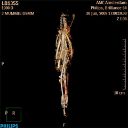In 2009, the mummy was taken from its usual home in LeidenIn 1930, almost two thousand years after it was so elaborately wrapped, the mummy was purchased in Luxor by Leiden assyriologist Prof. Dr. de Liagre Böhl. In 1951, Böhl’s collection of antiquities, mainly consisting of cuneiform clay tablets but also containing some Egyptian artefacts, was sold to the Netherlands Institute for the Near East (NINO), where it still resides today See: E. J. Holwerda, The Egyptian objects in the Böhl collection at the Netherlands Institute for the Near East in Leiden MA thesis Egyptology; Leiden, 2010. to the Academic Medical Center in Amsterdam for a CT-scan. The scans produced 3D images of the mummy and its contents, which you can admire in figs. 1, 2 and 3. This way, the ‘contents’ of the mummy could be studied without the need to unwrap (and therefore damage) it.
Looking at these scans, the researchersRadiographer Martin Poulus, ornithologist René Dekker and Egyptologist Esther Holwerda See: E. J. Holwerda, The Egyptian objects in the Böhl collection at the Netherlands Institute for the Near East in Leiden (MA thesis Egyptology; Leiden, 2010)).came to a fascinating conclusion: the animal inside these mummy wrappings was not a falcon at all, but actually an owl! In fact, the legs of the animal are detached from its head and rump, and belong to yet another (unfortunately undeterminable) species of bird.See: E. J. Holwerda, The Egyptian objects in the Böhl collection at the Netherlands Institute for the Near East in Leiden (MA thesis Egyptology; Leiden, 2010).
These discoveries beg some important questions. Why isn’t there a falcon inside these wrappings? Why did the person who mummified this owl pretend that it contained a falcon? And who were they trying to deceive?


